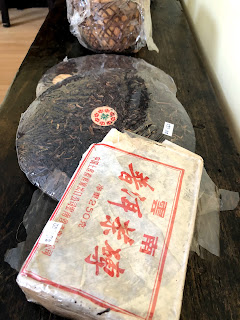This is one of the three pieces I picked up at a local Traditional Chinese Medicine pharmacy in town.
To me it is the most unlikely to be what the sellers says it to be so it
should be the easiest to confirm out of the three purchases that day. I actually would have not even bought it if
it wasn’t for me verifying the authenticity of the other “1970s” bings. It is definitely the long shot out of the
three.
As I said in the initial post, the herbalist was told they
were 50 years old puerh from his herbal distributor. He couldn’t verify the claim. He said it came from Hong Kong. He said that it’s the best tasting puerh that
he’s carried- much better than the other 2 cakes I purchased. He says that he is not a puerh tea drinker. I remember that these bricks were not
available for purchase in this same shop in 2009 when I picked up a 2004 Xiaguan tuo for a few bucks.
After inspecting the wrapper closely, it looks newer than
the 50 year old claim so immediately I am doubtful. The wrapper paper looks and feels like the
newer type of wrappers used and there isn’t the telltale signs of aging that
you would expect on a 50 years aged brick such as yellowing/ browning, teats
and holes, and other wear. If it was
stored in Hong Kong I’m pretty sure it would have at least some of these signs after
50 years.
I open the plastic wrap sealing this cake and the dry leaves
are a deep reddish colour. Dry leaf
smells of woody odours and piled autumn leaves with a faint plum odour. It looks and smells like shu puerh to me. The obvious piled autumn leaf odour indicates
that this tea hasn’t really mellowed out for 50 years. The odour would be mellower and not as sharp. Also, there is a complete absence of old
storage notes to the dry leaf at all. No
dusty, musty, attic, old library odours what so ever. A 50 year old tea is sure to have some of
this. Maybe it was just really dry stored for a long long time and kind of
preserved in this state? It is terribly
dry here on the Canadian prairie…
The first infusion is impressive, much better than expected,
but a bit inconspicuously lively…
It starts off creamy and sweet with a pronounced date and
creamy sweet nuance in leafy woody aged tastes.
The taste is very sweet and ends is a cool menthol on the breath. The mouthfeel is oily and lubricated with a
very slight mild graininess and almost astringency left on the tongue and
throat. The aftertaste is long and very
enjoyable. The sweetness is a thick
dense syrupy sweetness.
The second is very thick, dense, oily and heavy syrupy
sweetness. There is also a light
sweetness as well gliding overtop the heavier sweetness. Deep leaf pile and slight wood give this aged
tea solid complexity. There is a deep
low smokiness as well. This tea seems
like it is a shu puerh from 5-10 years old tops. It’s hard for me to tell exactly now old but
likely between 5-10 years not 50. Qi is a
bit relaxing and stimulating but nothing too out of the ordinary.
The third infusion starts off with a typical creamy sweet
shu puerh notes. The aftertaste is
creamy and slightly sweet. The mouth has
a certain astringency to it. There is a
leafy piled taste and woody taste to it.
At this point it seems obvious to me that this is for sure shu puerh and
most likely mid-late 2000s is my guess.
The fourth infusion starts again with a creamy
smoothness. This tea is so shu puerh-
creamy sweet dense slightly cooling aftertaste.
Slight woody notes, creamy almost icing sugary on top. The mouthfeel is full and slightly sandy on
the tongue.
The fifth infusion is much the same. There is a slight scratchiness to the
throat. It really tastes like some
standard shu to me here. It contains the
classic shu base profile taste. It’s not
at all bad but not 20 years old, never mind 50 years. There is a nice vanilla note that is pretty
long in the throat in the sixth infusion.
There is a bit of dry astringency in the throat.
The seventh is becoming astringent and drying with a dry woody
leaf taste. There is a slight cooling. The stamina is not there.
This ones the dud.
For $47.00 for 250g.
This tea is not worth it but still a totally drinkable item. I have actually gone to this puerh at work a
few times and quite enjoyed it.
My guess is a 5-10 year old shu- nice enough to enjoy as a
daily drinker.
Peace













